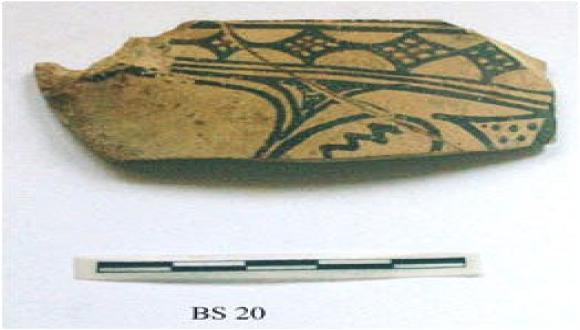Examination of Imported LHIIIC Pottery from Israel
Directors
Assaf Yasur-Landau Haifa University
Anna-Lucia d’Agata CNR, Roma
Hans Mommsen Universität Bonn
Yuval Goren Tel Aviv University
Forward
The relatively small quantity of imported LHIIIC pottery found in Israel is of unique importance to questions of
Aegean trade and chronology in the 12th century, since it mostly comes from stratigraphical contexts that can be dated using Egyptian objects. As such, it is the only source for absolute dates for probably most of the LHIIIC period. Its mere presence opens numerous questions concerning the nature of interregional interactions in a period when international trade is thought to be largely terminated, following the end of the Mycenaean palaces and the turbulence in the Near East, some of which is attributed to Aegean raids and migration.
Previous research was conducted on some parts of this assemblage, mainly identifying and using part of the pottery from Beth Shean as a chronological anchor for the absolute date of the LHIIIC period (Hankey 1966; Warren and Hankey 1989: 164-165). Provenance study (using NAA) of the stirrup jar from Tell Keisan (Balensi 1981; Gunnewag and Perlman 1994) had shown a Cypriote origin for the vessel.
However, our understanding of LH/LMIIIC regional styles and phasing within the period was immensely improved in the last few years (e.g. Deger-Jalkotzy 1998; Mountjoy 1999; D’Agata 1999). Concepts about the chronology of the end of the Bronze Age and the Egyptian domination in Canaan have been seriously challenged (e.g., Finkelstein 1995). Finally, questions of continuation of trade through the turbulence of the early 12th century (e.g., Sherratt 1998; Bauer 1998), call for reevaluation of the source and nature of trade in Aegean pottery.
Aim of research
The reexamination of the imported LHIIIC material from Israel will address two major topics: the absolute chronology of the LHIIIC ware and the nature of trade in LHIIIC pottery to Israel.
- LHIIIC chronology:
- Are absolute dates for the LHIIIC period, unconnected to historical reconstructions, attainable?
- Can absolute dates be given to sub-phases of the LHIIIC according to the present evidence?
- International trade in LHIIIC pottery to the Levant:
- What is/are the origin(s) of the vessels: Do they come from one region or from several, and is their origin within the Aegean world, or in areas “Aegeanized” in the 12th century (i.e., Cilicia, Cyprus etc.).
- Containers vs. tableware: Do the LHIIIC imports comprise mainly of containers with a minority of tableware (perhaps a distant mirror, on a much smaller scale of the LHIIIB imports, dominated by containers)?
- Duration of contact: Was pottery imported throughout the LHIIIC period, or just at its very beginning? How did the fall of Ugarit and the Aegean settlement in Cilicia and Cyprus influenced the importation of pottery to Israel? Finally, was the import chronologically earlier to the settlement of Aegeans in Philistia and the local production of LHIIIC pottery (Killebrew 1998: 159-160; Finkelstein 1995: 225) or was there a contemporaneity of interactions with the Aegean world: trade with northern Israel, and settlement in the southern coast.
Methodology and sample
A combination of NAA analysis, a thin section analysis (petrography) and stylistic analysis of a sample of sherds and vessels appears optimal for addressing the research questions posed. Thus for example, information about provenance will be best obtained when data from NAA and petrography is supplemented by stylistic analysis of the sherd, with respect to regional style. Chronological questions, however, will be answered chiefly by a comparison of the relative chronology within the LHIIIC period as manifested in the style of the sherds in the sample, to the absolute chronology available in some of the sites (especially Beth Shean), by the occurrence of datable Egyptian objects in the strata containing the imported LHIIIC pottery.
Our sample includes a total of ca. 40 vessels and sherds from Beth Shean, Acco, Dan, Megiddo, and Aphek.
Advances so far
The samples have been gathered, and the vessels were drawn, photographed, catalogued and sampled. We were privileged to receive an INSTAP grant, which enabled us to fund the processing of the NAA and the thin section samples. In February 2003 we received preliminary results of both the NAA and the thin section analysis, and are now at the beginning of the process of analysing the results and compiling first answers to our research questions.
Bibliography
Balensi, J. 1981. Tell Keisan. Témoin original de l’apparrition du ‘Mycenénien IIIC:1a’ au Proche-Orient. RB 88: 399-401.
Bauer, A.A. 1998. Cities of the Sea: Maritime Trade and the Origin of Philistine Settlement in the Early Iron Age Southern Levant. OJA 17: 149-168.
D’Agata, A.-L. 1999. Defining a Pattern of Continuity during the Dark Age in Central-Western Crete: Ceramin Evidence from the Settlement of Thronos/Kephala (Ancient Sybarita). SMEA 41/2: 181-218.
Deger-Jalkotzy, S. 1998. The Last Mycenaeans and Their Successors Updated. In: Gitin, S., Mazar, A. and Stern, E., eds. Mediterranean Peoples in Transition. Thirteenth to Early Tenth Centuries BCE. Jerusalem: 114-128.
Finkelstein, I. 1995. The Philistines in Canaan. Tel Aviv 22: 213-239.
Gunneweg, J.P. and Perlman, I. 1994. The Origin of a Mycenaean IIIC:1 Stirrup Jar from Tell Keisan. RB 101: 559-561.
Hankey, V. 1966. Late Mycenaean Pottery at Beth-Shan. AJA 70: 169-171.
Killebrew, A.E. 1998. Mycenaean and Aegean-Style Pottery in Canaan during the 14th-12th Centuries BC. In: Cline, E. and Harris-Cline, D. eds. The Aegeans and the Orient in the Second Millennium (Aegeum 18). Liège: 158-166.
Mountjoy, P. 1999. Regional Mycenaean Decorated Pottery. Radhen/Westf.
Sherratt, S. 1998. “Sea Peoples” and the Economic Structure of the Late Second Millennium in the Eastern Mediterranean. In: Gitin, S., Mazar, A. and Stern, E., eds. Mediterranean Peoples in Transition. Thirteenth to Early Tenth Centuries BCE. Jerusalem: 292-313.
Warren, P. and Hankey, V. 1989. Aegean Bronze Age Chronology. Bristol.



